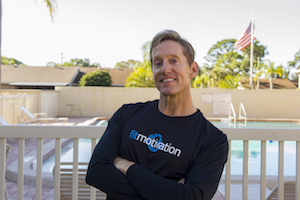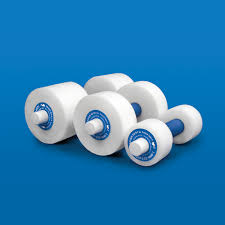

Nearly every pool has foam dumbbells and participants love to use them! In some places they use dumbbells for every class. Often they grab the largest dumbbells available. Is this a good thing?
The Metroplex Association of Aquatic Professionals hosted Mark Grevelding at a Continuing Education Training on April 21. One of his workshops was a Noodle & Buoy Circuit. Mark discussed exercise safety with dumbbells. He says that the main thing people do with dumbbells is push them forward and plunge them down.
Every time you submerge foam dumbbells under water, your shoulder stabilizers contract. When you push dumbbells forward you are using them like drag equipment. Your latissimus dorsi and lower trapezius contract isometrically to hold the dumbbells under the water. You get some work for the targeted muscle groups (chest and triceps), but these are not the muscle groups that get most of the work. Plunging the dumbbells down uses the shoulder stabilizers and works the triceps. It is easy to see that too much of this will put undue stress on the shoulders, which can lead to a shoulder injury.
Not only do some people use the dumbbells for every workout, but they also select the largest dumbbells available. They may not be able to keep the shoulders neutral with equipment this buoyant, so the shoulders are elevated. They may not be able to control the dumbbells without throwing their body weight into the exercise. They may have to reduce the range of motion as a result of this loss of control. It is easy to see that too much of this will put undue stress on the shoulders, which can lead to a shoulder injury.
So what are foam dumbbells good for? Well, I’d love to show you some pictures of exercises with the dumbbells, but when I Googled pictures of water exercises with foam dumbbells, all they had were pictures of pushing them forward and plunging them down! So you’ll have to use your imagination. Choose a size that you can manipulate while keeping the shoulders relaxed and the spine in neutral alignment. Relax your shoulders and fingers between each set. Use the dumbbells for only part of a class.
- Chest. In a lunge position, lean forward 45 degrees and perform a chest fly, like clapping your hands, or a chest press, pushing at an angle toward the floor.
- Lats. In an upright lunge position, perform a lat pull-down, like jumping jacks arms.
- Triceps. In a squat or lunge position, with elbows by the waist, perform a triceps extension. Or plunge the dumbbells down at the sides.
- Squats and lunges. Hold the dumbbells down at your sides while you perform these exercises to add resistance as you lower the body toward the floor.
- Calf raises. Hold the dumbbells down at your sides while you rise up on your toes to add resistance as you lower your heels back to the floor.
- Plank and side plank. Hold both dumbbells directly under the shoulders for the plank and one dumbbell directly under the shoulder for a side plank.
There are a lot of muscle groups missing from this list, like the upper back, shoulders and biceps. That’s because foam dumbbells only add resistance when you are pushing them toward the pool floor. The buoyant dumbbells want to float to the surface of the water, which means there is no resistance for any exercise that involves lifting them. Another thing missing from this list is using the buoyant dumbbells for support in a suspended position. When the body is suspended from dumbbells held in the hands or placed under the arms, the shoulders are unacceptably loaded, the tendons are pinched, and nerve damage may occur in the arm pits (Ivens and Holder, Do No Harm, 2011).
The bottom line is that foam dumbbells are a lot of fun and they offer some good resistance for a limited number of exercises. For more information on using dumbbells, including a chart showing which muscles are being trained with various exercises using buoyant equipment, see my new book Water Fitness Progressions. The book also contains lesson plans using dumbbells for both shallow water and deep water classes. The book can be ordered from Human Kinetics (the publisher) or from Amazon.com. Just click on whichever source you wish to order from and the link will take you there.
Mark Grevelding wrote about my book in his Blog. Check out his post at https://fitmotivation.com/blog
See you in the pool!

Chris Alexander

I need to to thank you for this fantastic read!!
I definitely enjoyed every bit of it. I have
got you book-marked to look at new things you post…